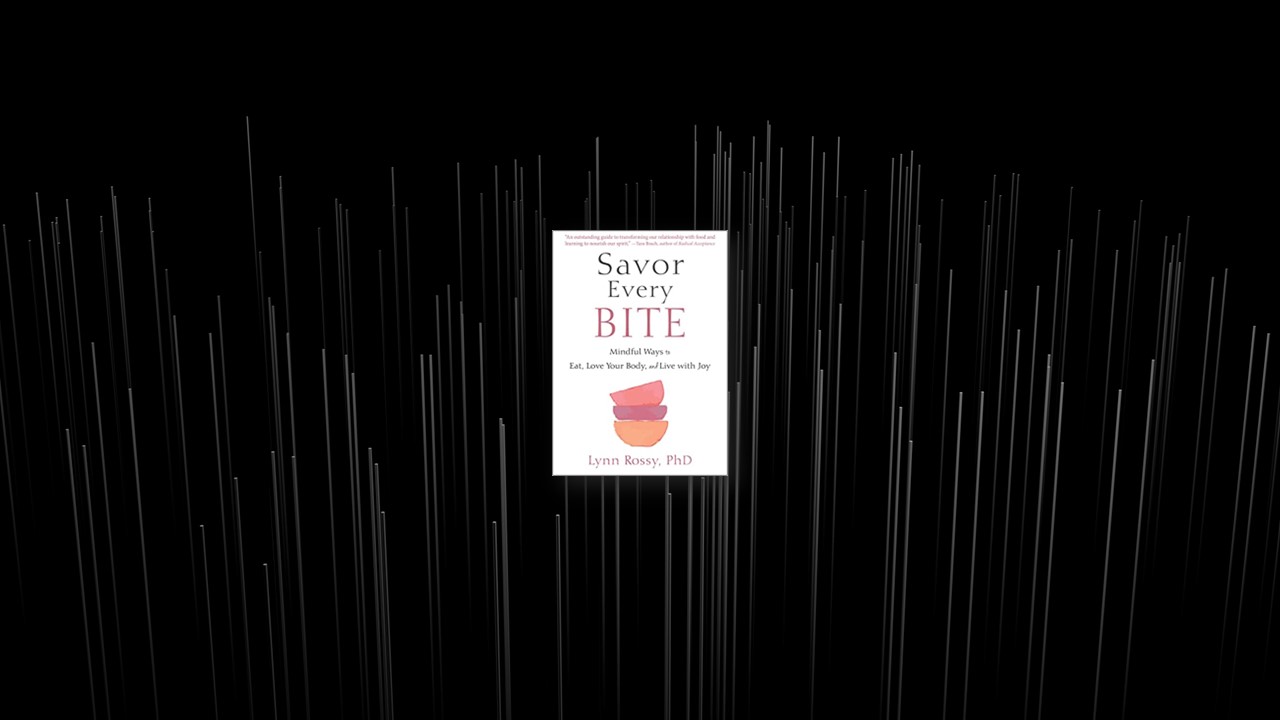When we were born, we were delivered without operating instructions. And somewhere along the way, the most instinctual acts we perform—such as eating and moving our bodies—have become quite complicated and confusing.
This little book does not provide a set of rules for you to follow; rather, you’ll find short, powerful practices in how to become present with your own internal wisdom and knowing heart. Inside of you is the teacher for almost all you need to know. Your body is the expert. Your heart is the guide. You can relearn how to listen to their soft and gentle voices pointing you toward nourishment and restoration.
Step One: Slow Down and Explore Your Senses
If you feel a lot of urgency to fix the way you eat, fix your body, or fix your life, you probably have the feeling of going around in circles without getting anywhere. The truth is there is nothing to fix, but much to explore with curiosity and kindness. By first slowing down, you are placing yourself in the perfect position to hear the answers from within that tell you what you need to know about the food you eat, what your body wants and needs, and the truth of who you are.
Slowing down and exploring your senses as you eat is only the beginning. As you learn to luxuriate in the moments you have with food and your body, your entire life naturally becomes suffused with the beauty of mindful attention and love. Slowing down helps you notice more, and what you notice can teach you volumes about the most important aspects of life. The answers are already waiting for you; all you need to do is slow down to listen.
Step Two: Soothe (Instead of Eat) Your Emotions
Reacting to emotions, from the difficult to the delightful, is one of the top reasons for overeating reported by people who come to my classes. Eating in reaction to difficult emotions—like sadness, anger, loneliness, boredom, stress, disappointment—reduces discomfort. Eating in reaction to delightful emotions—like happiness, joy, excitement—is a way to celebrate. Eating food in either instance is not inherently bad, but it’s important to be compassionately conscious about when and how much you use eating as a strategy to manage emotions.
Particularly when difficult emotions arise, you have probably noticed that eating provides only temporary relief of the discomfort and momentary happiness. Eating as a solution becomes a set of new problems: feeling too full (sometimes when you weren’t even physically hungry to begin with); experiencing shame (blaming yourself for being a bad person for doing it); and guilt or regret (which often arise as a result). Thoughts like Why did I eat so much? What is wrong with me? When will I ever learn? I feel disgusting! create more difficult emotions than we started with.
Step Three: Surrender Limiting Thoughts
It’s been estimated that we have between thirty-five and forty-eight thoughts per minute (or fifty thousand to seventy thousand thoughts per day), and most of them are negative, repetitive, and false. These “automatic thoughts” arise out of nowhere, exist, and pass away, over and over again throughout the course of the day, and they often wreak emotional havoc on the uninitiated. The uninitiated to mindfulness, that is. Without an understanding of how to listen and respond to the thoughts in your head, you can often feel at their mercy. Mindfulness teaches you how to be with thoughts without becoming them. You can see their patterns and behaviors and transform them through your loving awareness.
The key is to befriend these thoughts, not to believe them or fight them. This concept can be difficult to grasp, but it is essential to your ability to respond in a supportive way and to heal from the cognitive patterns that you have laid down in your brain over your lifetime. Whatever types of thoughts you have given attention to over the years (worrying, planning, regretting, and so on) have established neural pathways in your brain. If you stop reacting to these thoughts and feeding them energy, they won’t go away entirely, but they will definitely lessen over time. It’s like when you stop putting sticks on the fire and it eventually dies out. The same is true for thoughts. When you stop feeding them, they die out as well.
Step Four: Smile and Create Your Own Happiness
Now that you are learning to slow down, soothe your emotions, and surrender limiting beliefs, you are perfectly prepared to add the next step—smile and create your own happiness. People are often surprised that mindfulness is not just about being present; it also includes cultivating the positive in life. The wisdom and clarity that you uncover with the skill of awareness can be used to create what you want, from a positive relationship to food and your body to a greater sense of joy and delight in living. This is why mindfulness is also called “insight” practice. The more often you can be present without judgment, the more available you are to insights about how to guide your actions when you eat, move, and live in ways that reduce suffering and create greater happiness.
The Buddhist practice of skillful effort describes how to work with mindful insights for your greatest benefit. Skill effort is accomplished in four ways:
- Become aware of thoughts and behaviors that create suffering.
- Through your awareness of their impact, let go of the thoughts and stop the behaviors that create harm.
- Develop and cultivate thoughts and behaviors that enhance your well-being.
- Maintain these thoughts and behaviors through your conscious effort.
Since eating in response to difficult emotions or simply because food is in the environment can become problematic, cultivating the positive in multiple areas of your life can reduce the number of times that food becomes the leading answer for feeling good. These practices require your kind, compassionate attention together with the willingness and courage to make some gentle effort to support your own well-being.
Step Five: Savor Every Moment
What does it mean, to savor? Here’s a definition from positive psychology: “When one savors, one is aware of pleasure and appreciates the positive feelings one is experiencing.” This implies that you could be experiencing something pleasant but not savoring it, because you aren’t even aware of it, much less appreciating it. Thus the important ingredients for savoring are both your presence and your appreciation when pleasant sensations arise.
While we don’t deny that there are challenging, difficult aspects of life, your attention to savoring can enhance your ability to see how often and under what circumstances the pleasures in life occur. Fleeting pleasures of tasty food, buying new shoes, or getting a raise (hedonic pleasures) as well as deeper pleasures resulting from meaningful work, generosity, and a value-driven life (eudaimonic pleasures) can both be experienced to produce an additive effect instead of sacrificing one for the other.
The practice is to experience each moment as it arises but to not cling to anything, wanting it to remain longer than it naturally exists—this is the Buddhist definition of suffering. Savoring requires that we experience, let go, and trust that there will always be more to savor later.
In fact, life offers us a smorgasbord of delights each day, from each mindful meal, to watching your child take their first step, to meeting a goal that’s important to you. Savoring is when you intentionally try to make positive emotions last longer or be stronger. Starting with savoring every bite, you can expand your capacity to savor the entire fabric of your life, woven with layers of pleasure you may often overlook.


